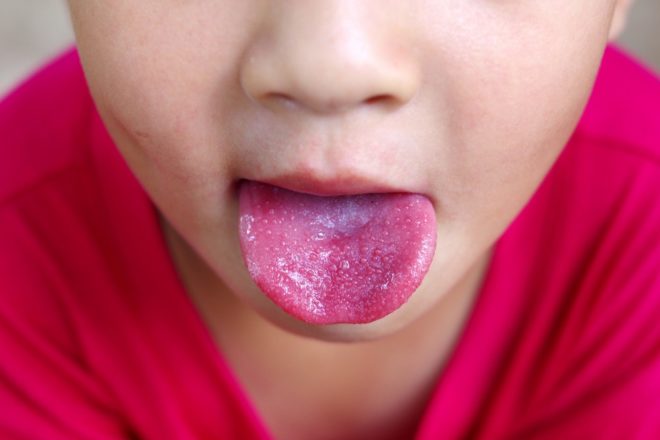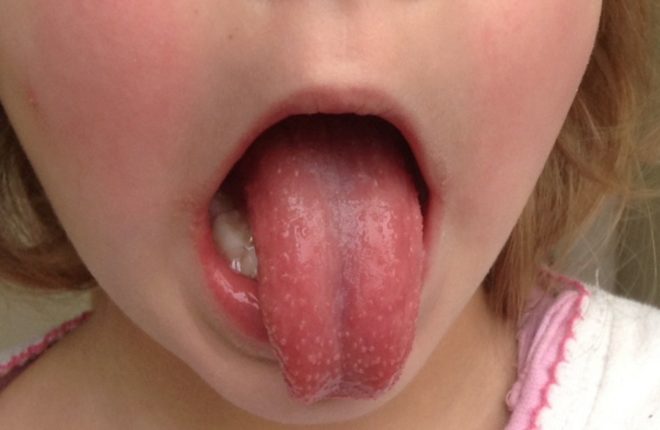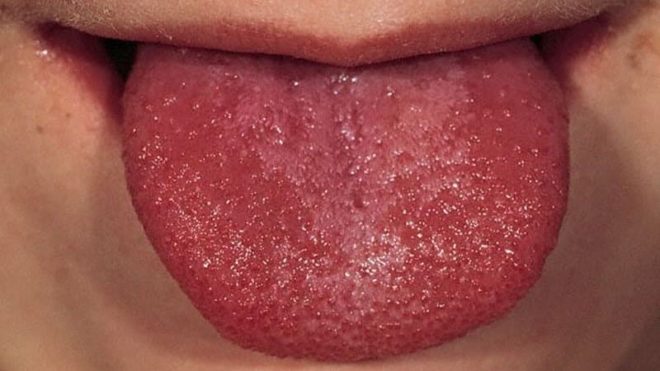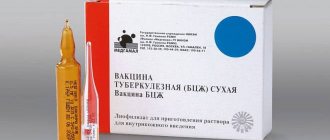Who gets scarlet fever most often and when?
Most often, children from 3 to 15 years old suffer from scarlet fever. Newborn children receive immunity from their mother. This immunity protects the baby for about one year. It lasts longer the longer the mother breastfeeds. Children from one to three years old get sick less often simply because they have less contact with peers. When a child begins to attend kindergarten or school, the likelihood of infection increases sharply.
By the age of 15, children come into contact with most varieties of group A streptococcus and develop immunity to them. This means that the risk of developing the disease in adults is small. Scarlet fever is seasonal. Most often, children get it in winter or early spring.
Vaccine prevention of scarlet fever: does it exist?
Currently, partial or complete immunization of the population is one of the main methods of preventing serious infectious diseases in adult patients and their children. Vaccinations against life-threatening diseases of a child begin from the first day of his life. Infants with normal body weight and without complex developmental defects or severe forms of pathology of visceral organs are vaccinated in accordance with the national vaccination schedule against tuberculosis, tetanus, whooping cough, diphtheria, measles, hepatitis B, and rubella. It is recommended to administer the hepatitis B vaccine to newborns immediately after birth, and to vaccinate against tuberculosis on the third day of life.
The viruses against which vaccinations are made have the highest mortality rate and are often accompanied by complications. The primary administration of vaccine preparations followed by revaccination allows you to create an adequate immune response of the body to contact with pathogens, thereby protecting the baby from infection. Vaccinated children are completely protected from fatal diseases. Even when infection does occur, the disease will proceed very mildly and in a mild form, without causing deterioration.
The first scarlet fever vaccine appeared at the beginning of the last century. It contained weakened pathogens and their toxins. In the 20s of the 20th century, scientists proposed increasing the dose of streptococcal toxins in the medicine, and two decades later - purifying it with aluminum hydroxide. Years later, vaccination of children with a vaccine containing only scarlet fever and diphtheria toxin was proposed. The suspension was administered to several hundred patients, but the result could hardly be called positive. The new vaccination suspension had a number of disadvantages:
- a significant number of adverse reactions;
- a single application of the solution is insufficient to form reliable immunity;
- low efficiency.
With the beginning of the era of antibiotics, the urgent need for the invention of a scarlet fever vaccine disappeared by itself. It turned out that streptococcal microorganisms (including the causative agents of scarlet fever) are very susceptible to penicillins. Today, with adequate antibiotic therapy, the disease goes away without consequences in 3-5 days. Therefore, scarlet fever vaccination has lost its significance.
Scarlet fever vaccination is not currently offered in children's clinics. It is not included in the mandatory vaccination schedule, and it cannot be found for free sale in pharmacy chains. The reason for this phenomenon is known. Scarlet fever vaccination simply does not exist, that is, there is no vaccine that stimulates the production of specific protection against the virus. The development of similar immune drugs has not been carried out for a long time.
The main reasons for refusing anti-scarlet fever immunization:
- scarlet fever is characterized by a mild course and a virtual absence of documented complications;
- symptoms of the infectious process disappear within a few days if properly treated with antibiotics and follow all doctor’s recommendations;
- it is a disease with a low mortality rate (by the way, seasonal flu claims many more lives than scarlet fever);
- It is impossible to infect a breastfed child under 12 months with scarlet fever, since he receives protective antibodies from his mother's milk.
Scientists have completely stopped developing a vaccine for the immunoprophylaxis of scarlet fever. They are convinced that there is no urgent need for its introduction, since the disease does not pose a threat to people’s lives. In addition, any vaccination is an additional burden on the human immune system, so you should not expose it to stress again.

Even if a decision has been made to use the vaccine solution, you must remember that it does not last long. Most likely, the child will need several preventive injections before reaching the age of ten. And each time such a procedure will become a real test for the immune system, increasing the risk of consequences. An important fact is that a child who has recovered from the disease develops persistent antibodies, that is, long-term immunity is formed, which can be enough for a lifetime.
How is scarlet fever transmitted?
Only people get scarlet fever. Pets cannot be a source of disease. It is transmitted by airborne droplets. For example, when coughing or sneezing. A contact route of transmission is possible - through unwashed hands: by direct touch, through dishes, toys, care items.
With closer contact, the likelihood of disease is much higher. That's why children who attend kindergartens and primary school get sick more often. In this case, the source of infection does not necessarily have to be sick. Especially if this person is an adult. He may simply be a carrier of the infection. This is the reason that many mothers and fathers at my appointment claim that the baby did not meet anyone who was sick, but only communicated with his closest relatives.
How does scarlet fever occur?
General symptoms:
- acute onset with an increase in temperature to high numbers. Can reach up to 40*C;
- severe weakness, fatigue, malaise, drowsiness, loss of appetite, headache;
- sometimes, as a manifestation of intoxication, nausea and vomiting may occur (one or more times at a high temperature and feeling unwell).
Local symptoms:
- rash. It usually begins 2-3 days after the onset of the disease, but it can also be the very first sign of the disease. Sometimes, with a mild course, a rash may be the only manifestation of scarlet fever. The rash begins from the head and chest. Then it gradually spreads to the whole body. It intensifies in the natural folds of the skin - inguinal, axillary, elbow, knee. Sometimes solid red stripes may form at the folds. Externally, the rash is bright, almost scarlet. If you look closely, you can see tiny bubbles. To the touch it rises somewhat above the surface of the skin, rough. If you press, it turns pale under your finger. Sometimes children are bothered by itching;
- peeling. 3-4 days after the onset of the rash, it begins to gradually turn pale, and the skin in its place dries and peels. At the same time, the scales are very small - 2-3 mm each. Not very noticeable to the eye. Only on the fingers and toes will peeling be pronounced, and the skin will peel off in large thin layers;
- the face has a characteristic appearance - the cheeks are very bright, red. The nasolabial triangle, on the contrary, is very pale;
- changes in the mouth. At the very beginning of the disease, the tongue is covered with a thick white coating. Under it you can see large edematous papillae. After a couple of days, the tongue is cleared of plaque and becomes bright scarlet with clearly defined papillae on it. This is the so-called “raspberry tongue” - a characteristic symptom of scarlet fever. There may be changes in the pharynx characteristic of sore throat. The tonsils become enlarged, reddened and covered with a white or yellowish coating. If you try to pick out the plaque with a spatula, it is easily separated from the tonsil.
What additional examinations do I need to undergo?
Throat culture or rapid test
In typical cases, the diagnosis is made based on examination and does not require additional research. However, according to international recommendations, before prescribing antibiotics, the child is advised to do a throat culture for flora and sensitivity to antibiotics. Sowing on blood agar, provided proper preparation, is a very sensitive method - up to 95% probability of a correct result. It has only one drawback. You will have to wait 1-2 days for the results. Rapid tests have been developed for faster diagnosis. Their sensitivity is slightly lower. Ranges from 60 to 85%. However, the result can be obtained immediately and without delaying the start of treatment.
In order for a culture or rapid test to show a more accurate value, the child should be properly prepared for the analysis. It will be most effective to do the test in the morning before the baby has eaten, drunk or brushed his teeth. If the test is not done at home, but in a laboratory, it should also not be fed or watered at home. It is allowed to do the test or culture not in the morning, but at least 2 hours must pass from the next meal or drink. If the test is done independently at home, it is important for parents to strictly follow the attached instructions. And take a smear strictly from the surface of the tonsils, it is better from that part of them where the plaque is more abundant. This will increase credibility.
General blood analysis
A general analysis can also be quite informative. It will help the doctor distinguish scarlet fever from a viral infection or an allergic reaction with an unclear clinical picture, and promptly recognize complications.
If complications occur or are suspected, consultations with specialized specialists - ENT, cardiologist, nephrologist - may be necessary; or additional examinations - general urinalysis, biochemical blood test, x-ray, ultrasound, etc.
How to treat scarlet fever?
Scarlet fever is one of the few childhood infectious rashes that can be treated with antibiotics. It must be said that the infection will most likely go away without prescribing an antibiotic, but this greatly increases the risk of complications. Streptococcus is highly sensitive to many types of antibiotics. Penicillins are considered the drugs of choice for children. The doctor must decide which drug is best. It is important to remember that the course of antibiotics for scarlet fever should be at least 10 days.
Despite the fact that the child’s condition usually improves within 2-3 days of taking the medicine. Such a long course is necessary to avoid severe complications of streptococcal infection.
What is scarlet fever

The causative agent of the disease belongs to the group of streptococci and affects the kidneys, joints, and tonsils.
In children, signs of infection appear immediately. In adults, the picture of the disease may be blurry, but the consequences in the form of complications are always serious.
If treated with penicillin-based antibiotics, complications can be avoided. The insidiousness of the disease is that at the first stage it resembles a cold, its symptoms are similar to ARVI, sore throat or sinusitis.
What else can I do to alleviate the condition?
In addition to antibiotics, the child is prescribed local antiseptics and anesthetics - sprays or lozenges. They will help reduce pain and inflammation in the throat.
Sometimes at high temperatures, especially in young children, dehydration can occur. In this case, the baby needs to be given plenty of water. You can also use special pharmaceutical solutions for soldering.
If there is a high temperature and poor health (headache, chills, severe weakness), the doctor may recommend giving the child an antipyretic and analgesic.
Proper care for a sick child is important. For sore throats, warm and sometimes cool drinks and thick drinks (for example, jelly or smoothies) help well. Lollipops are good for soothing sore throats. Not necessarily pharmacy ones, you can give simple candies. It is important to avoid drying out the mucous membranes. Use saline solutions and home humidifiers, ventilate the room. Try to limit physical activity and organize quiet leisure time.
The rash does not require separate treatment. There is no need to spread anything on the skin. Only at the recovery stage, with severe peeling, can wound healing or vitamin ointments be used, after consultation with a doctor.
Symptoms of scarlet fever
The incubation period for scarlet fever is from 2 to 7 days. The onset of the disease is acute. The temperature rises (up to 38-39°C), the patient shudders, has a headache, feels weak, and may experience nausea or vomiting. At the same time, symptoms of tonsillitis appear - a sore throat when swallowing; upon examination, inflamed and enlarged tonsils, a “flaming pharynx” (redness of the soft palate and the back wall of the pharynx) are found. The tongue is covered with a white coating. However, on the 3rd - 4th day of illness, the coating disappears, the tongue becomes crimson in color, and its surface becomes granular.
Rash
Quite quickly (by the end of the 1st or 2nd day of illness) a rash appears: even redder, numerous very small dots stand out on the reddened skin. The rash covers the entire body, but is concentrated in the natural folds of the skin, in the lower abdomen and on the sides of the torso. The rash fades away after 3-7 days, leaving no pigmentation behind. After the rash disappears, the skin begins to peel off, and comes off in layers on the palms and soles. This usually occurs on the 14th day of illness.
More about the symptom
How can scarlet fever be dangerous?
Provided timely treatment, scarlet fever practically does not cause any complications and goes away completely without a trace.
If antibiotic therapy is not started in a timely manner, acute infectious complications may occur - otitis media, sinusitis, abscesses. The child will complain of a sharp deterioration in health, a repeated increase in temperature to higher numbers. With otitis media, pain in the ear is bothersome. In children, an analogy may be that the child grabs the ear and rips it. Sinusitis causes intense headaches, especially pronounced when bending the head forward or making sudden movements. With a peritonsillar abscess, the pain sharply increases when swallowing, opening the mouth, or turning the head to one side. All these complications require urgent consultation with a doctor and prompt treatment.
Somewhat later, non-purulent complications may develop. Usually 10-14 days after recovery. The most common are reactive arthritis, rheumatism (joint damage), post-streptococcal glomerulonephritis (kidney disease), carditis (heart damage). In order to prevent the development of serious complications, the doctor will advise you to take a general urine and blood test, first a week later, and then 3 weeks after recovery. If there are indications, the doctor may recommend an ECG at the same time.
Scarlet fever vaccine
Before antibiotics were invented, there was no effective treatment for scarlet fever. The complications were severe: purulent lesions, depression of the functions of the kidneys, heart muscle, brain, and nervous system. In some cases, the infected person died.

In 1905, the first vaccine against scarlet fever was created. Its name has not been preserved. It consisted of a weakened virus and a tiny fraction of its toxins.
The results did not live up to expectations, the immune system gave a weak response to it, after administration, many side effects were observed, patients were repeatedly infected with streptococcal infection. It was not possible to improve the drug.
The difficulty of developing a vaccine
After 20 years of hard work, scientists and doctors have come to the conclusion that treating the infectious disease is easier and safer. Its prevention is ineffective; moreover, a person who has recovered from scarlet fever develops stable lifelong immunity.
Streptococcus is highly resistant to various chemical and physical influences, and it is almost impossible to destroy it.

They become infected by airborne droplets and contact. Pathogens spread quickly in closed communities. Pathogenic microorganisms provoke serious autoimmune diseases. Finding a prophylactic against the pathogen has become an impossible task for scientists.
Is it possible to prevent the disease?
There is no specific prevention of streptococcal infection. There is no vaccine for scarlet fever. To prevent infection, you should follow the rules of hygiene:
- washing hands after walking and before eating;
- avoiding close contact with people with tonsillitis or scarlet fever;
- individual dishes. Parents and other family members should not eat from the child's plate; use his spoon; lick your baby's pacifier, bottle, or food;
- Try to isolate a sick family member and provide him with separate hygiene products and utensils. Try to wash and treat them separately (do not put the toothbrush in a common glass; allocate a separate cup, spoon and plate for the entire period of illness; use a separate towel for washing).
History of the vaccine
Scarlet fever is an old disease that has been extensively studied by specialists since the 1500s. In the 1800s, the negative effect of streptococcus on kidney function was established, and the bacterium was discovered in the tonsils of an infected person. Before the creation of the first penicillin antibiotics, all possible methods of treating infection did not bring results. Patients inevitably suffered from complications, and many cases of death were known. Delayed complications of the disease also led to death. In the 19th century, the task of scientists was to develop a vaccine against hemolytic streptococcus.
The first vaccination was created at the beginning of the 20th century - 1905. The serum contained a neutralized microbe and the toxins it secreted. The first tests did not show the formation of stable immunity. Vaccinated people had a hard time with vaccination and still became infected with streptococcus. Scientists spent another 20 years perfecting the immunomodulatory drug. But this vaccine did not live up to expectations.
The first scarlet fever vaccine required five immunizations. The body’s protective reaction lasted for 2 years, after which the person needed vaccination again.
The drug for the treatment of hemolytic streptococcus (penicillin antibiotics) was first introduced and used in 1928. Since then, the urgent need to create a vaccine has disappeared. Clinical trials of the antimicrobial drug have confirmed safety and high efficiency compared to the created vaccine.
When can I send my child to school or kindergarten?
Despite the fact that the child ceases to be contagious 2-3 days after starting to take antibiotics, Russian Guidelines recommend releasing the child into an organized group no earlier than 12 days after recovery (21 days from the onset of the disease). During these days, the child should receive full treatment and a course of examination to prevent complications.
Often, when parents at an appointment hear from me a diagnosis of scarlet fever, they get scared. In fact, this infection is not that bad. Scientists have noted that in modern children the disease is somewhat milder than before. With timely and correct treatment, scarlet fever goes away quickly and, almost always, without consequences.
Other preventative measures
Scarlet fever is not an infection with the status of particularly dangerous pathologies. Despite this fact, epidemiologists continue to insist on immunoprophylactic measures, the main goal of which is to neutralize pathogens. Infectious diseases specialists tend to think that only the introduction of quarantine in children's institutions where outbreaks of the epidemiological process are registered can stop the spread of infectious agents and prevent infection of healthy children.
If a child with scarlet fever is identified in a preschool institution or school, quarantine is immediately introduced. Responsibility for the organization and implementation of the event lies with the director, manager and representative of the medical staff. To prevent the spread of the disease process, you need to adhere to quarantine measures:
- Those who are ill are prohibited from attending kindergarten or school for 21 days from the onset of early symptoms. The first three weeks of illness are described in the scientific literature as the most dangerous for those around him. At this time, the patient continues to release microbes into the environment.
- Before starting classes, all students must undergo a primary medical examination, during which a nurse assesses their general health, measures their temperature, listens to complaints and examines the skin, mucous membranes of the oral cavity, and natural skin folds.
- In all rooms, it is important to carry out wet cleaning several times a day, wiping toys, interior items, and furniture with a washcloth soaked in a disinfectant solution.
- During the quarantine period, soft plush toys are taken out of rooms, carpets are removed and aired outside, having previously been treated with antiseptic agents.
- For comprehensive and reliable disinfection, you can take toys and carpets to the dry cleaner, which will completely get rid of pathogenic bacteria.
For any form of scarlet fever, the patient must be placed in an inpatient ward or provided with isolated conditions at home. If, while treating the baby at home, he develops signs of worsening of his painful condition, then he must be hospitalized immediately.

What is hidden behind the phrase quarantine at home? This concept means placing the sick person in a separate room with the provision of separate hygiene products, utensils, towels, bed linen, etc. When washing, the patient’s clothes must be boiled and then ironed. Such items should not be washed together with the clothes of healthy family members, so as not to expose them to the risk of infection.
Compliance with home quarantine includes a number of rules:
- a sick child should not have contact with other relatives, especially if we are talking about children of the first three years;
- Only one family member should care for the patient;
- the first week, bed rest is indicated, and after seven days the patient can get up and move around the room;
- You should not force a sick person to eat a lot, as this may cause vomiting;
- It is recommended to give the baby water frequently, which will help reduce the symptoms of intoxication;
- Dairy products, pureed soups, vegetable puree, meat pate, rosehip decoction, fruits and berries are introduced into the diet;
- treatment in practice is implemented with the participation of therapeutic, pediatric specialists and infectious disease specialists;
- You cannot engage in self-medication, traditional medicine, or healing.
Quarantine for scarlet fever lasts no more than 10 days. At the end of it, the tomboy cannot go to kindergarten or school for another 11 days. This measure allows you to avoid the spread of bacterial infection in the team, which is transmitted by airborne droplets. Children who have had contact with the infection are observed by doctors. They are subject to quarantine for seven days. It is important to understand that children with weakened immune systems can become ill again if they come into contact with a sick person.

Scarlet fever is not as dangerous as a number of diseases of viral origin. Therefore, basic rules of personal hygiene, such as frequent hand washing, a balanced diet, and avoiding hypothermia, will help prevent an epidemic. In modern medical practice, people are not vaccinated against scarlet fever. Treatment of the condition is unacceptable without antibacterial medications, which, by destroying pathogenic bacteria, allow the patient to recover faster. If you refuse antibiotics, the disease will lead to complications:
- rheumatism of the heart;
- kidney damage – glomerulonephritis;
- other autoimmune diseases of internal organs and joints.
The course of antibacterial and restorative therapy lasts about ten days and allows the child to completely return to a healthy lifestyle. As a result, vaccinated patients develop stable immune protection.







